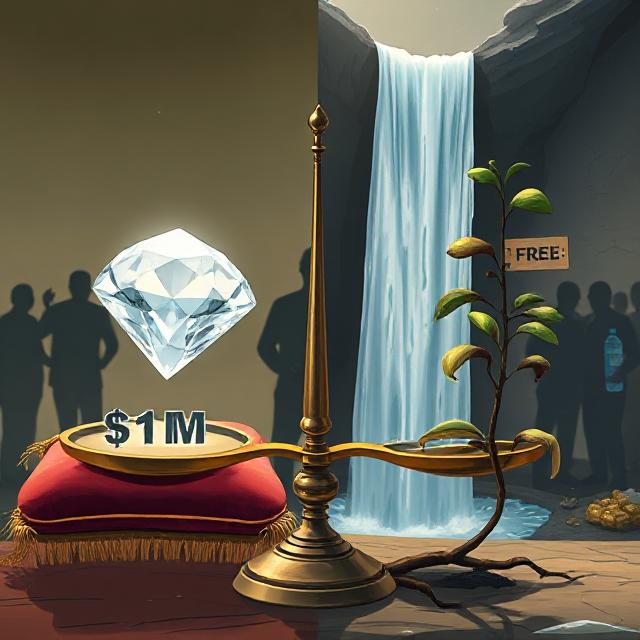
Table of Contents
Paradox of Value: Why Water Is Cheap, Diamonds Aren’t
The Paradox of Value, sometimes called the Diamond-Water Paradox, is one of the oldest puzzles in economics and philosophy. It asks a seemingly obvious but deeply perplexing question:
Why is something essential like water cheap, while something non-essential like diamonds is expensive?
This contradiction strikes at the core of how we assign worth, make decisions, and interpret human desire. To solve this paradox, we need to look at history, economics, marginal utility, and even human psychology.
I. The Historical Origins: From Plato to Adam Smith
The paradox has ancient roots. Greek philosophers like Plato and Xenophon pondered the relationship between necessity and value.
But the question gained prominence in modern economics thanks to Adam Smith, the father of classical economics. In The Wealth of Nations (1776), he wrote:
“Nothing is more useful than water: but it will purchase scarce anything… A diamond, on the contrary, has scarce any value in use, but a very great quantity of other goods may be had in exchange for it.”
Smith was puzzled by the discrepancy between use value and exchange value:
- Use value: Water is vital for life.
- Exchange value: Diamonds fetch high prices.
How could something so essential be so economically undervalued?
II. Defining the Two Values
A. Use Value
This refers to how useful an item is to a person or society. Water scores high here—without it, we die.
B. Exchange Value
This refers to how much someone is willing to trade for the item. Diamonds, though not essential, have high exchange value due to rarity and demand.
The paradox lies in the mismatch. It feels irrational that life-sustaining resources are cheap while symbolic luxuries are expensive.
III. Marginal Utility: The Modern Resolution
Enter marginal utility, a key concept from the marginalist revolution of the late 19th century.
Marginal utility is the additional satisfaction or usefulness gained from one more unit of a good.
Let’s apply it:
- If you have no water, your first sip is priceless.
- If you already have a gallon, another glass isn’t as valuable.
- But diamonds are scarce; any single one still feels precious.
In short, value is not determined by total usefulness but by marginal usefulness.
Water is abundant in many places, so its next unit doesn’t seem very valuable. Diamonds are rare, and their next unit is highly desired.
IV. Real-World Applications and Examples
A. Pricing of Essentials vs. Luxuries
- Bread vs. Truffle Oil: Bread feeds millions, yet costs less than gourmet condiments.
- Air: Invaluable to life, but free—until you’re in a submarine or space capsule.
B. Emergency Economics
In crisis zones, the paradox flips:
- Water becomes more valuable than gold.
- Scarcity + necessity = skyrocketing marginal utility.
C. Digital Goods
Think of apps, e-books, or music. Infinite copies can be made, so marginal cost is near zero, and price often reflects perceived rather than functional value.
V. Psychological Perspectives
A. Perception and Rarity
Humans often associate value with scarcity and desire, not practical utility.
B. Symbolic Value
Diamonds carry emotional weight:
- Engagement rings
- Family heirlooms
- Status markers
Their price reflects social meaning as much as material reality.
C. Anchoring and Marketing
Brands can increase perceived value by manipulating context:
- Displaying high-end items beside cheaper ones to influence perception
- Suggesting exclusivity (“limited edition”)
These tricks shift focus from use to symbolism.
VI. Philosophical Questions Raised
A. What Is Value?
Value is not objective; it’s assigned by individuals or societies.
- Is art valuable? To whom?
- Is gold useful? Outside electronics, not really.
B. Can Markets Be Rational?
Markets often reflect wants, not needs.
- Does that make them irrational?
- Or are they merely expressive of desire?
The Paradox of Value forces us to ask: should price reflect importance—or popularity?
VII. Critiques and Alternative Theories
A. Labor Theory of Value
Marx and Ricardo suggested value stems from labor input. Diamonds cost more due to labor-intensive mining.
But that doesn’t explain:
- Natural diamonds vs. synthetic ones
- Handmade goods that are cheap due to low demand
B. Ecological Economics
Some argue that natural resources should be priced by ecological value or replacement cost, not just scarcity or demand.
C. Ethics of Pricing
Why should insulin cost hundreds while soda is cheap?
- Raises questions about market failures
- Highlights the gap between value to life vs value to markets
VIII. Paradox in a Changing World
As climate change reshapes global priorities:
- Water scarcity may make its value skyrocket.
- Environmental valuation may shift pricing structures.
Likewise, lab-grown diamonds and synthetic substitutes challenge the traditional value hierarchy.
IX. Lessons for Consumers and Thinkers
- Don’t equate price with worth. The most important things are often free.
- Be aware of scarcity bias. Rare does not always mean valuable.
- Question symbolic purchases. Are we buying meaning, status, or utility?
- Understand opportunity cost. Every choice carries unseen tradeoffs.
X. Conclusion: The Value of Understanding Value
The Paradox of Value reveals more than an economic glitch—it shows us how deeply human psychology and social context shape markets. It teaches us to look beyond price tags and ask: what really matters?
We live in a world where diamonds shine brighter than water on price sheets—but only until thirst strikes. This paradox isn’t a failure of economics—it’s a mirror of humanity.
Understanding this helps us make wiser choices—not just as consumers, but as citizens and stewards of the world.
